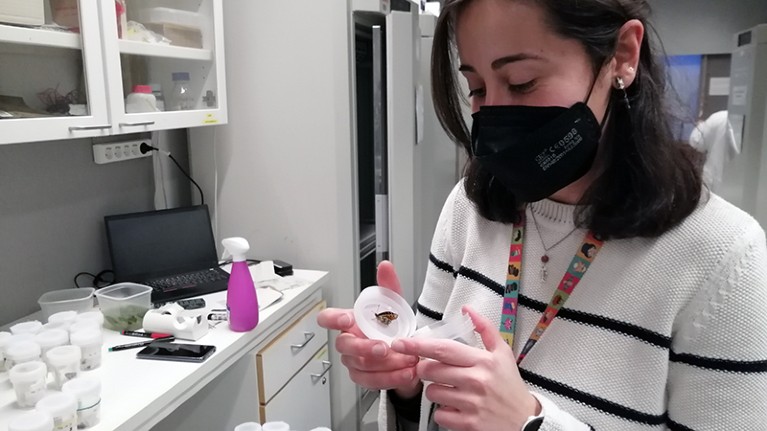My productivity waxes and wanes — and I’m learning to account for it


Camila Souza Beraldo advises planning work activities to accommodate your own energy cycles.Credit: Emy Guilbault
I started my PhD in ecology and evolution only two months before the onset of the COVID-19 pandemic. As an immigrant from Brazil at the University of Helsinki, I had only scant and recently established social connections, so adapting to those challenging times proved particularly arduous. The dissimilarity between Finnish culture and language and my own transformed the process of settling into my PhD into more of a hurdle than an enjoyable experience. At the same time, I was constantly preoccupied with concerns about the well-being of my family and friends back in Brazil.
Despite Finland’s relatively under-control pandemic situation, the pressure to persist in planning fieldwork, conducting experiments and pursuing publications was unrelenting. Gradually, my initial enthusiasm for this new chapter in my life waned, making it increasingly challenging to concentrate on my academic pursuits. The sense of unproductivity and difficulty coping became pervasive. I saw tasks piling up in my to-do lists: samples to sort; manuscripts to write; classes to prepare; DNA to extract; e-mails to answer; assignments to submit. I wondered whether I would ever be able to get out from under that mess of incomplete tasks I’d set myself — a feeling that will be familiar to many PhD students who find that the pressure to be consistently hyper-productive weighs on their psyche.
What helped me to fight those feelings of guilt and of never doing enough were insights from two other women and their thoughts on cycles of productivity.
Redefining productivity
One evening in 2021, amid the hustle of conducting experiments, a friend recommended the Instagram profile of Yasmim Barroso (@flordemim), a Brazilian content creator who posts about personal development. Barroso is one of those people who can talk about routine, habits and planning without selling a magic solution or making you feel guilty for not achieving your goals. According to her, the conventional idea of productivity as achieving more with fewer resources is antiquated.
Time tracking for early-career researchers: a practical guide
Instead, Barroso defends a personalized definition of productivity tailored to an individual’s circumstances. In her videos, Barroso challenges her followers to articulate their own definition of a productive day. For example, in the past year, I’ve had productive days in which I have written two or three paragraphs of a manuscript to be submitted and attended a seminar or group meeting; analysed a set of data and produced one or two figures; or marked assignments by ten students and studied one or two papers for a journal club. It is through this personalized benchmark that one can authentically assess whether a day has been productive or not.
Furthermore, Barroso contends that using practical tools can make the concept of productivity more concrete. For instance, by conceptualizing an ideal routine and using strategic yearly, monthly and weekly planning, individuals can translate the abstract notion of productivity into tangible and achievable actions.
Barroso also advocates considering one’s reserves of emotional energy when gauging productivity. On stressful, difficult or emotionally fraught days, fewer tasks will be completed, and so, by most standards, a person might seem less productive. But during moments of heightened anxiety, for instance, the most truly productive actions might simply involve taking a refreshing shower, eating something and taking the time to calm down. Barroso emphasizes that specific tasks completed should not be the sole measure of productivity because of this concept of emotional flexibility. On some days, responding to e-mails might constitute the best we can give. On others, managing to teach, oversee experiments, lead meetings and engage in writing might represent the same 100%.
These ideas deeply resonated with me. Amid the chaos I found myself in, I was sure I was exerting my utmost effort, even if it seemed minimal on some days. Simultaneously, emotional exhaustion left me grappling for words or coping mechanisms to articulate my struggles and be more compassionate towards myself. Barroso’s guidance helped me to recognize that I was internalizing shame and guilt for not meeting academia’s productivity expectations. Instead, I learnt to account for my internal fluctuations and set more concrete and achievable goals.
Managing my time and my energy
Building on this, last year I read the 2019 book Do Less by Kate Northrup, which I found to shed light on a truth often overlooked in the scientific community. She observes that a person’s 100% is not a constant, given the dynamic nature of our selves across days, weeks, months and years.
Northrup contends that a deeper understanding of our bodies, their behaviours and the nuances of our cycles can lead us to harness energy more effectively for specific tasks. In her book, Northrup introduces the idea that various cycles, including menstrual and yearly seasonal ones, impact an individual’s energy levels. She suggests aligning at least part of our activities with each of these cycles for optimal energy efficiency. For instance, I noticed that during the first two days of my period, I experience mood swings, often feeling more sensitive or irritable than on other days. On the basis of this observation, whenever it’s possible, I schedule easy tasks during this time and avoid arranging difficult conversations or evaluative meetings. Similarly, researchers dealing with chronic illness, other health concerns or care-giving responsibilities should note their own energy patterns throughout a week or month and arrange their working days accordingly.
Time management for scientists
Both Barroso and Northrup highlight the significance of managing energy alongside time. This involves observing and reflecting on the fluctuations of our bodies and minds over time and experimenting with strategies to optimize our energy while respecting our personal limits.
I must acknowledge that shifting the ingrained concept of productivity has been challenging. As I enter my third year of using the planning tools I have acquired, I sense gradual progress. Each passing year allows me to incorporate a bit more, and I’m pleased to observe that these tools are guiding me towards untangling the extensive to-do list that accumulated during the pandemic.
Currently, my typical benchmark involves aiming for four to six deep work hours each day, including active participation in meetings or seminars. This is my average goal, but I’ve become more attuned to the idea that expecting the same output on some days — such as those affected by premenstrual syndrome — might lead to frustration, considering the physical discomfort I experience. Therefore, I redefine my expectations on such days. This is not merely an act of being gentler on myself but a conscious effort to align my workload with what I can realistically achieve.
Embracing a concept of productivity that considers the variation in our minds and bodies isn’t just healthier — it’s freeing. We are all doing our 100%.
Competing Interests
The author declares no competing interests.






